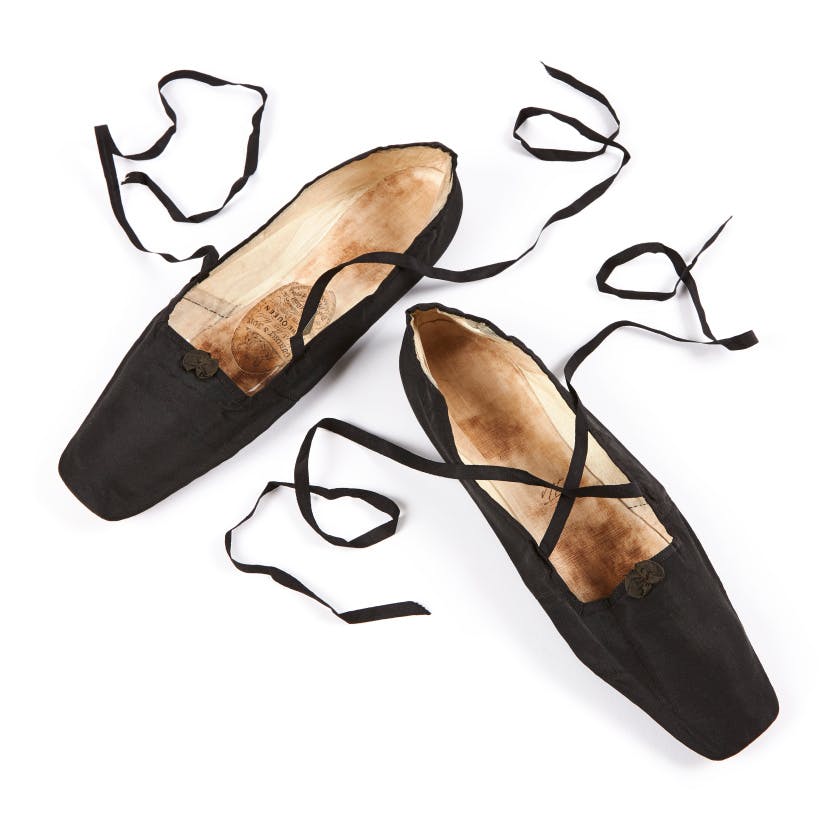Young Queen Victoria's shoes in the Royal Ceremonial Dress Collection
Date: 11 November 2016
Author:
Claudia Acott WilliamsA recent trip to a little auction house nestled in the heart of the Cotswolds yielded some very exciting results. We came back to London laden with 15 items of dress worn by Queen Victoria and her children.
The objects, which ranged from tunics and petticoats to gloves and shoes, have now been accessioned into the Royal Ceremonial Dress Collection and we’ve set about the task of researching them.
Some exploration of the provenance of the objects revealed that they had been passed down the generations by direct descent from Samuel Bagster the Elder. Samuel was founder of publishing firm Bagster & Sons who supplied bibles to King George IV, King William IV and Queen Victoria.
Queen Victoria was well acquainted with Samuel’s wife, Eunice Bagster, and it was through this connection that these objects found their way into the hands of the Bagster family.
I began my research into our new hoard by looking at a pair of Queen Victoria’s shoes. The shoes are made of a black silk satin and fasten with black satin ribbons. The oval label in the right-hand shoe gives us a very useful insight into the makers and their customers.

Image: Eunice Bagster, 1876. Royal Collection Trust / © Her Majesty Queen Elizabeth II 2016
The growing volume of production generated by the Industrial Revolution in the 19th century led to the development of wider print advertising and shoes were some of the first items of apparel to bear such labels.
This one tells us that the slippers were made by Gundry & Son who were the Queen’s primary boot and shoe makers throughout her life, and are thought to have made both her coronation and wedding shoes. The label reads, “Gundry & Son, Boot & Shoe Makers to the Queen, the Queen Dowager, Their Royal Highnesses the Duchess of Kent & Princess Sophia/1 Soho Square, London”, alluding to the company’s noble clientele.
It would appear then, that celebrity product endorsement is no new phenomenon in the fashion industry. Just as we see today with fashion labels worn by the Duchess of Cambridge, makers have always been keen to capitalise on their relationships with the social elite to boost sales and a royal commission could, and still can, propel a company to success.

Image: Lithograph of Queen Victoria and Prince Albert, showing Victoria wearing black satin slippers. Royal Collection Trust / © Her Majesty Queen Elizabeth II 2016
In the lithograph (left), Victoria is depicted wearing a similar pair of black satin slippers. Like the pair in our collection, they are cloth-topped, have a square toe, no heel and would also have used delicate ribbons to tie around the ankle.
Slippers such as these became the footwear of choice for fashionable women of the early 19th century. Simple footwear became associated with refinement of manners and reflected women’s position within the home as well as the revival of dance and the stage.
In the 1840s and 50s, coloured shoes were deemed to be terribly vulgar and white satin, black satin or cream kid leather were considered the elegant choice.
Typically, white satin would have been worn to evening occasions and black would be used for formal day dress. The elaborate buckles which had been so popular amongst the elite during the 18th century were abandoned in favour of delicate satin rosettes and bows, such as we see on our pair. The effects of this seemingly minor shift in tastes had major ramifications: as a result the buckle trade in Birmingham collapsed throwing an estimated 20,000 men and women out of work.
Victoria spent liberally on shoes, as this page from the Office of Robes Accounts Ledger from March 1838 shows. As a curator, the wonderful thing about shoes is that they are bursting with clues about where and when they might have been made and worn.
This new addition to our collection has already offered us a wealth of insights into Victoria’s day-to-day attire as well as the fashions and advertising methods of the day and there are still more clues to unpick!
Claudia Williams
Assistant Curator
Listen to the podcast
In the fourth part of this series, we’re taking a walk with curator Claudia Acott-Williams into her favourite space at Kensington Palace, the room where Queen Victoria was born. Claudia will explain how this room was intentionally chosen as the birthplace of the future Queen of England.
More episodesMore from our blog

Little Vickelchen': sketches of Queen Victoria as a girl
26 May 2019
A unique set of sketches in our collection show Princess Victoria at three years old, on holiday in the seaside town of Ramsgate, Kent in 1822. They give us a rare informal glimpse of Victoria as a pink-cheeked cherub and a bundle of energy.

Conserving Queen Victoria's Jacket
21 December 2018
Behind the scenes with Textile Conservator Beatrice Farmer as she prepares a beautiful pink embroidered jacket, once owned by Queen Victoria, for display.

Queen Victoria's petticoat wrapped up!
18 December 2017
In the last post we saw how Queen Victoria's petticoat has been conserved. It is now stable enough to be displayed and enjoyed by our visitors! However, for the time being, the petticoat will be carefully packed and stored within our Royal Ceremonial Dress Collection.

